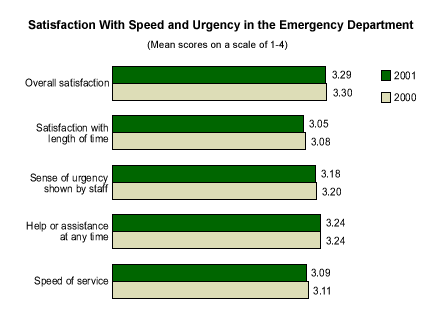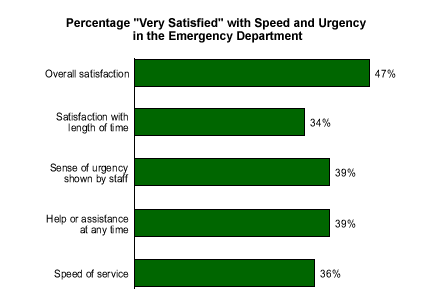Want to focus on your hospital's greatest opportunity for quality improvement? Look to the emergency department. Gallup has traditionally found patient satisfaction with the ED to be the lowest of any hospital service tracked. One of the implications is that inpatient satisfaction scores may also be lower among patients admitted to the hospital through the emergency department than among patients admitted through other departments. Rapid growth in high acuity cases, antiquated facilities, and staffing shortages led the American Medical Association to declare a state of crisis for emergency departments in 2002.
Where to Look for Improvement
What is the greatest barrier to improvement in the ED? The obvious answer is in the very name: "emergency" department, which implies unexpectedness and urgency. Patients come to the ED without advance planning for a problem that requires immediate attention. Whether it is a heart attack or a cut finger, patients want immediate action. Speed of service is the defining expectation of an ED. How well do hospitals measure up?

Gallup's patient satisfaction database shows that the four lowest-scoring core measurement attributes for EDs all relate to urgency and speed:
- Satisfaction with length of time
- Speed of service
- Sense of urgency shown by staff
- Getting help or assistance at any time
All four attributes score well below overall satisfaction with the ED. Further, while 47% of patients report being very satisfied with their ED experience, only 34% are very satisfied with the length of time spent in the ED. This indicates that staff dedication is partially overcoming dissatisfaction with the department's core function, speed of response.

Patient satisfaction with speed of service and length of time in the ED is low and has declined in the past year. The degree of urgency shown by staff members is not rated positively, but the ability to get help if needed does score higher. These findings illustrate both the positive and negative aspects of the triage system. Triage identifies and prioritizes those with major problems. If someone has a serious problem (such as a heart attack), it will be handled quickly. Conversely, while a cut finger may be viewed as urgent to the patient, the triage system downgrades its urgency. Staff members can become jaded, giving the patient a feeling of insignificance: "It's only a cut finger, we have urgent problems to treat."
For all patients, a trip to the emergency department is an unplanned occurrence that requires immediate action. But for staff members, some patients' conditions may be viewed as minor and not requiring immediate attention. This perceptual gap negatively affects satisfaction with speed of service.
How Can We Improve?
- Continually reinforce with staff members that in the ED, all patients view their conditions as important.
The most acute patients must be treated first. However, ED staff members must not give any patients the impression that their condition is unimportant. This message is insulting and can cause a patient to leave without receiving service.
- Greet all patients immediately, listen to their problems, and explain how and when they will be served.
As a patient, how would you react to entering an ED, seeing a sign that tells you to fill out a form, placing the form in a basket, and then waiting to be called for service? Unlike waiting to be served at a deli, any visit to the ED is an emotionally charged situation -- patients want to see a live person immediately, have him or her listen to their problems, and show sensitivity to their needs for service.
- Maintain ongoing communication with patients and their families.
The ED is a stressful and uncertain environment. In a situation of urgent need, sitting in a waiting room or treatment cubicle surrounded by confusing activity lends to fears of having been lost in the shuffle. Ongoing communication reassures patients and their families that they have not been forgotten.
- Implement bedside registration.
Wait to be registered. Wait in the waiting area. Wait in the treatment cubicle. Patients perceive this as redundant waiting time with no progress toward treatment. The one proven way to improve waiting time scores is to implement bedside registration, where registration is handled after the patient is sent to a treatment cubicle.
- Implement a minor emergency track in the emergency department.
It is the minor emergency that the current system discriminates against. Yet these patients, when seen, often require the fewest resources and the least expertise. This problem is relatively easily addressed by establishing during peak hours a minor emergency treatment system staffed by physician assistants and/or nurse practitioners to respond to patients exhibiting minor injuries or conditions.